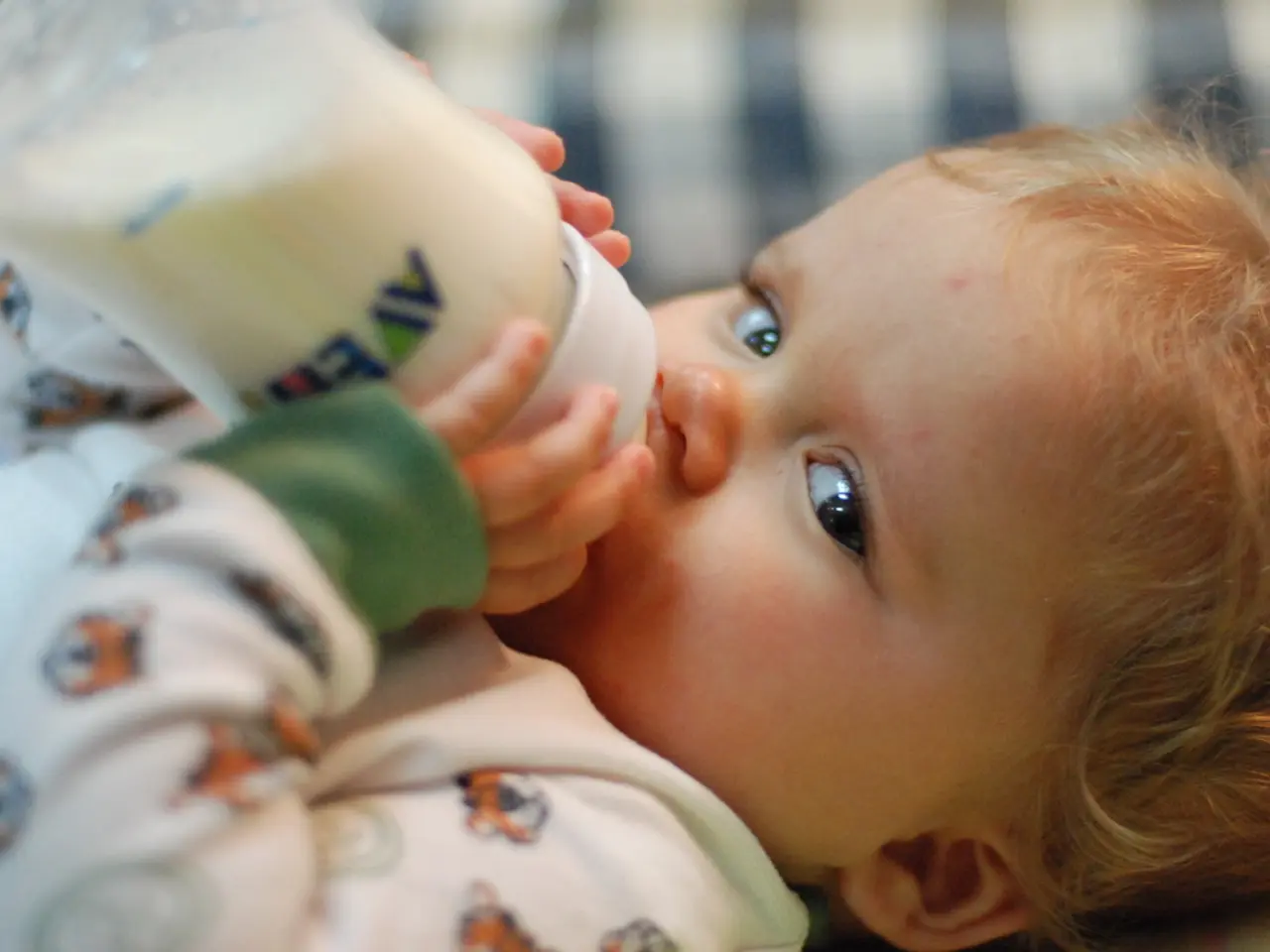Breastfeeding-Related Jaundice and Breast Milk's Role - Understanding Causes and Remedies
Newborn jaundice, a common issue affecting many infants, can be linked to breastfeeding. Two types of jaundice related to breastfeeding are breastfeeding jaundice and breast milk jaundice.
**Causes**
Breastfeeding jaundice, which typically occurs in the first week of life, is primarily caused by insufficient intake of breast milk, resulting in mild dehydration and reduced bowel movements. This, in turn, delays the elimination of bilirubin, a yellow pigment, causing it to build up in the baby's blood.
On the other hand, breast milk jaundice, which usually appears after the first week and can last several weeks, is caused by certain substances in the breast milk that interfere with the liver's ability to process bilirubin properly.
**Risk Factors**
Breastfeeding jaundice can be influenced by premature birth, improper feeding schedules, latching issues, pacifier use, and family history of breast milk jaundice. Meanwhile, breast milk jaundice is more likely to occur in babies with a family history of the condition.
**Treatment Options**
The primary treatment for breastfeeding jaundice is to ensure the baby is feeding well, with frequent breastfeeding to improve hydration and increase bilirubin elimination. Sometimes, supplementation with expressed breast milk or formula is recommended if milk intake is insufficient. Phototherapy may be used if bilirubin levels are high.
For breast milk jaundice, phototherapy is often used to lower bilirubin levels. Breastfeeding can usually continue alongside treatment. Temporary interruption of breastfeeding is very rarely needed and only considered if bilirubin levels urgently need to be reduced or phototherapy is unavailable. If breastfeeding is paused, mothers are advised to pump frequently to maintain milk supply.
**Phototherapy**
This is the main treatment for both conditions when bilirubin levels are elevated enough to require intervention. It works by breaking down bilirubin in the skin.
**Summary**
| Aspect | Breastfeeding Jaundice | Breast Milk Jaundice | |--------------------------|-----------------------------------------------|---------------------------------------------| | Onset | First week of life | After first week, may last weeks | | Cause | Insufficient breastfeeding causing dehydration and decreased bilirubin elimination | Substances in breast milk impair bilirubin processing | | Breastfeeding interruption | Rarely needed; focus on improving feeding | Very rarely needed; usually continue breastfeeding | | Treatment | Improve breastfeeding, possible supplementation, phototherapy if needed | Phototherapy; breastfeeding usually continues |
In all cases, maintaining breastfeeding with appropriate support is recommended, as breastfeeding jaundice and breast milk jaundice usually do not require stopping breastfeeding. Monitoring bilirubin levels and consulting a pediatrician for appropriate management is important to avoid complications.
If breast milk jaundice persists for several weeks, it is recommended for mothers to maintain their milk production by expressing milk and combining it with a formula to feed the baby. Formula supplementation can help increase fluid intake and lower bilirubin levels. Supplementing breast milk with sugar water is not recommended as it can hamper breast milk intake and production and further delay the decrease of bilirubin levels.
In some cases, treatment for jaundice in breastfed infants includes increasing feeding frequency, seeking help from a lactation professional, maintaining breast milk production, and using lactation aids if necessary. It is crucial to remember that every baby is unique, and what works for one may not work for another. Therefore, it is essential to consult a healthcare professional for personalised advice and guidance.
- Parenting often requires navigating medical-conditions, such as newborn jaundice, which affects many infants.
- Newborn jaundice can be linked to breastfeeding and has two types: breastfeeding jaundice and breast milk jaundice.
- Breastfeeding jaundice, occurring in the first week, is primarily caused by insufficient intake of breast milk, leading to mild dehydration and reduced bowel movements.
- This results in delayed bilirubin elimination, causing it to build up in the baby's blood.
- Breast milk jaundice, which appears after the first week, lasts several weeks and is caused by certain substances in the breast milk that interfere with the liver's ability to process bilirubin properly.
- Premature birth, improper feeding schedules, latching issues, pacifier use, and family history of breast milk jaundice can influence breastfeeding jaundice.
- Breast milk jaundice is more likely to occur in babies with a family history of the condition.
- The primary treatment for breastfeeding jaundice is to ensure the baby is feeding well, with frequent breastfeeding to improve hydration and increase bilirubin elimination.
- Supplementation with expressed breast milk or formula is sometimes recommended if milk intake is insufficient.
- Phototherapy may be used if bilirubin levels are high.
- For breast milk jaundice, phototherapy is often used to lower bilirubin levels.
- Breastfeeding can usually continue alongside treatment for breast milk jaundice.
- Temporary interruption of breastfeeding is very rarely needed and only considered if bilirubin levels urgently need to be reduced or phototherapy is unavailable.
- Mothers are advised to pump frequently to maintain milk supply if breastfeeding is paused.
- Phototherapy is the main treatment for both conditions when bilirubin levels are elevated enough to require intervention.
- It works by breaking down bilirubin in the skin.
- Maintaining breastfeeding with appropriate support is recommended, as both types of jaundice usually do not require stopping breastfeeding.
- Monitoring bilirubin levels and consulting a pediatrician for appropriate management is important to avoid complications.
- If breast milk jaundice persists for several weeks, it is recommended for mothers to maintain their milk production by expressing milk and combining it with a formula to feed the baby.
- Formula supplementation can help increase fluid intake and lower bilirubin levels.
- Supplementing breast milk with sugar water is not recommended as it can hamper breast milk intake and production.
- Treatment for jaundice in breastfed infants may include increasing feeding frequency, seeking help from a lactation professional.
- Maintaining breast milk production and using lactation aids if necessary can also be part of the treatment plan.
- Every baby is unique, and what works for one may not work for another, so it is essential to consult a healthcare professional for personalized advice and guidance.
- This understanding of newborn jaundice falls under the broader domain of science, particularly medical-conditions and health-and-wellness.
- Cybersecurity, environmental-science, and climate-change are other areas within the vast realm of science.
- Mental-health, mens-health, and womens-health are also crucial aspects of health-and-wellness, along with cardiovascular-health and skin-care.
- Therapies-and-treatments, both traditional and modern, play a significant role in managing various health issues, from chronic-diseases like cancer to respiratory-conditions and digestive-health problems.




